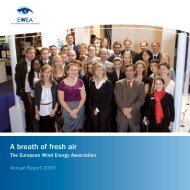Offshore Electricity Infrastructure in Europe - European Wind Energy ...
Offshore Electricity Infrastructure in Europe - European Wind Energy ...
Offshore Electricity Infrastructure in Europe - European Wind Energy ...
You also want an ePaper? Increase the reach of your titles
YUMPU automatically turns print PDFs into web optimized ePapers that Google loves.
The overall Split Design reduces the system costs by<br />
€15.8 bn across 25 years for a total <strong>in</strong>vestment cost<br />
of €5.4 bn.<br />
4.5.4 Comparison of methodologies<br />
It should be highlighted that both the Direct Design<br />
and the Split Design methodology lead to significant<br />
net benefits. Immediately the question raises which<br />
of the two leads to the most cost-efficient offshore<br />
grid design. Such a comparison would be most sound<br />
on an equal basis: either with equal total cumulative<br />
costs <strong>in</strong> order to see which design br<strong>in</strong>gs the most<br />
reduction <strong>in</strong> system cost, or with equal total system<br />
cost reduction <strong>in</strong> order to identify which design has the<br />
lowest CAPEX. In our case where neither equal system<br />
reduction costs nor equal CAPEX are given, comparison<br />
of relative benefits by evaluat<strong>in</strong>g the reduction <strong>in</strong><br />
system cost per <strong>in</strong>vested euro is most useful.<br />
In the follow<strong>in</strong>g paragraphs, a comparison is made<br />
based both on relative and absolute terms 36 . However,<br />
first of all it is <strong>in</strong>structive to shortly analyse the <strong>in</strong>-<br />
36 Please note that the overall cumulative <strong>in</strong>vestment costs and the reduction <strong>in</strong> system generation costs shown <strong>in</strong> Figure 4.30 to<br />
Figure 4.34 only consider the <strong>in</strong>vestments made for the steps described <strong>in</strong> paragraphs 4.5.2 and 4.5.3. The total costs of the<br />
overall grid design are further detailed <strong>in</strong> section 4.5.5.<br />
A number of cases does not follow this general rule.<br />
<strong>Offshore</strong>Grid – F<strong>in</strong>al Report<br />
Split Design Methodology -<br />
newly <strong>in</strong>stalled <strong>in</strong> each step<br />
Direct design -<br />
newly <strong>in</strong>stalled <strong>in</strong> each step<br />
terconnector capacities that come along with the two<br />
design approaches.<br />
Interconnection capacity – comparison for<br />
the direct and split design approach<br />
<strong>Offshore</strong>Grid starts to develop an overall grid design<br />
based on the Hub Base Case scenario 2030. This<br />
scenario <strong>in</strong>cludes all exist<strong>in</strong>g grid <strong>in</strong>frastructure and<br />
adds the connection of all 2030 offshore w<strong>in</strong>d farms<br />
with <strong>in</strong>dividual connections and hub connections<br />
where beneficial. The exist<strong>in</strong>g <strong>in</strong>frastructure exhibits<br />
an offshore <strong>in</strong>terconnection transmission capacity<br />
<strong>in</strong> Northern <strong>Europe</strong> of about 8 GW. Furthermore the<br />
planned <strong>in</strong>terconnectors of the ENTSO-E TYNDP were<br />
added, which represent further offshore <strong>in</strong>terconnection<br />
capacity of 8 GW.<br />
Thus, the overall grid design development with<strong>in</strong><br />
<strong>Offshore</strong>Grid starts with an offshore <strong>in</strong>terconnection<br />
capacity of 16 GW. Based on this the overall grid design<br />
is developed with the Direct and Split Design<br />
methodologies <strong>in</strong> three steps as aforementioned.<br />
FIGURE 4.30: cOMPARISON ThE cAPAcITY OF All EUROPEAN INTERcONNEcTORS TOdAY, WITh ThE ENTSO-E TYNdP<br />
INTERcONNEcTORS, WITh ThE ThREE STEPS OF ThE dIREcT ANd SPlIT dESING METhOdOlOGY<br />
<strong>Offshore</strong> <strong>in</strong>terconnection<br />
capacity (GW)<br />
40,000<br />
35,000<br />
30,000<br />
25,000<br />
20,000<br />
15,000<br />
10,000<br />
5,000<br />
0<br />
Exist<strong>in</strong>g<br />
<strong>Offshore</strong><br />
Interconnector<br />
Capacity<br />
ENTSO-E<br />
TYNDP<br />
Step 1<br />
Direct or<br />
Split design<br />
Step 2<br />
Hub-to-hub<br />
and Tee-<strong>in</strong><br />
Step 3<br />
Mesh<br />
Split Design - cumulative<br />
Direct Design - cumulative<br />
69









